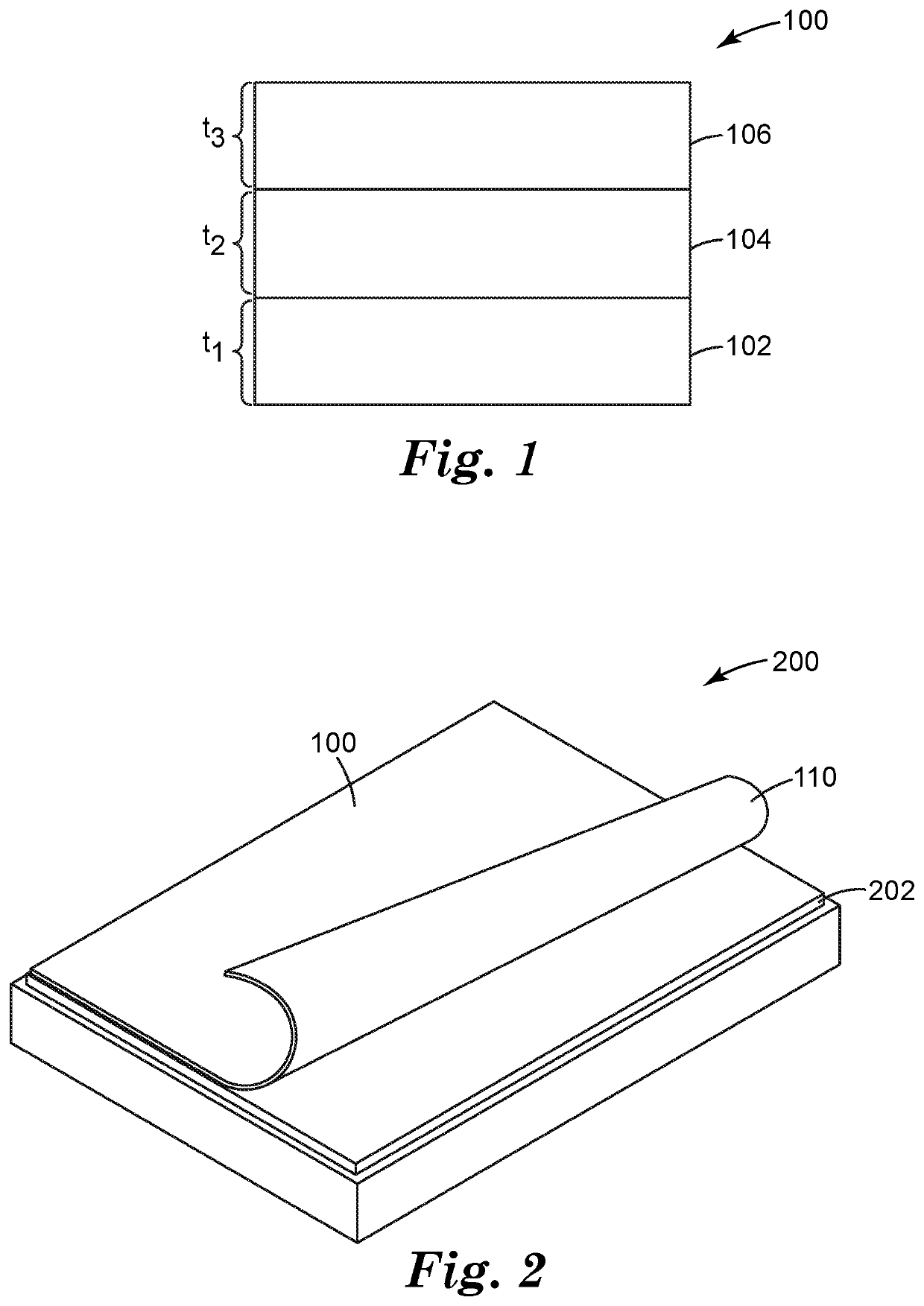Polymeric Membrane Useful As A Commercial Roofing Membrane
a polymeric membrane and commercial roofing technology, applied in the direction of synthetic resin layered products, domestic articles, constructions, etc., can solve the problems of compromising the waterproofing properties of the membrane are not adequate, and the waterproofing properties of the membrane are not strong enough to withstand, so as to improve the waterproofing characteristics and the effect of increasing the strength of the polymeric membrane and high the loading level of fillers
- Summary
- Abstract
- Description
- Claims
- Application Information
AI Technical Summary
Benefits of technology
Problems solved by technology
Method used
Image
Examples
examples a-f
[0057]Polymeric membranes comprising a foam structure and non-styrenic thermoplastic elastomers were prepared according to the following description. Examples A-D included a thermoplastic non-styrenic elastomer foam core layer and non-styrenic outerlayers prepared by feeding the components listed on Table 3, below, and 2 wt. % of azodicarbonamide (AZO) foaming agent (based on the total weight of the composition) into a 25 mm twin-screw extruder (TSE) using three K-tron feeders. To ensure good mixing of the filler into the non-styrenic thermoplastic elastomer, the twin-screw extruder screw speed was set to 150 revolutions per minute (RPM). The outer layers were made with single screw extruders, which were gravity fed with polymer pellets. All extruders were connected to a 3-layer die via heated hoses, with the twin-screw extruder feeding the core (center) slot of the 3-layer die. The 3-layers of polymer melt were joined inside the 3-layer die and the 3-layer molten film was cast onto...
example 1-13
[0061]Polymeric membranes comprising a foam structure and including styrenic thermoplastic elastomers were prepared as generally described in Examples A-F except that a linear triblock copolymer based on styrene and ethylene / butylene (SEBS, G1657) was used. In Example 11, the polymeric membrane was a dual-layer polymeric membrane comprising a SEBS core and TPO outer layer, prepared as described in Example A-F, wherein one of the outer layer extruders was turned off.
[0062]Compositions of Examples 1-13 are shown in Table 4 below.
TABLE 4FillerAmountSizeDensityExamplePolymerTypeLayersType(wt. %)(Microns)(g / cm3)Example 1SEBSFoam1NoneN / AN / A0.57Example 2SEBSFoam3NoneN / AN / A0.44Example 3SEBSFoam3NS3051.02Example 4SEBSFoam1NS30500.83Example 5SEBSFoam1NS3050.71Example 6SEBSFoam3NS30500.51Example 7SEBSFoam3NS60500.74Example 8SEBSFoam3NS6050.50Example 9SEBSFoam1NS6051.00Example 10SEBSFoam1MDH301.80.55Example 11SEBS (core)Foam2MDH301.87.50TPO (outer)NoneN / AN / AExample 12SEBSFoam1NoneN / AN / A0.46Exam...
examples g -
Examples G-S
[0063]Polymeric membranes comprising non-styrenic thermoplastic elastomers were prepared as generally described in Examples A-F, except that no foaming agent was used, and as a result, the thermoplastic elastomeric layers were extruded as films.
[0064]Examples L-R are single-layer membranes having thickness of about 30 mil. Examples L-O and Q additionally included 5 wt % of TiO2 and 1 wt % of B878T, based on the total weight of the polymer. Examples L and 0 used a SEBS / TPO blend.
[0065]Composition of Examples G-S are shown in Table 5, below. N / M indicates properties that were not measured for the referenced examples.
TABLE 5NumberFillerPolymericAmountSizeDensityExamplePolymerTypeLayersType(wt. %)(microns)(g / cm3)Example GSiloxaneFilm1NoneN / AN / A0.99Example HSiloxaneFilm3NS30501.06Example ISiloxaneFilm3NS3050.96Example JSiloxaneFilm3NS60501.15Example KSiloxaneFilm3NS6051.20Example LSEBS / TPOFilm1RP2200.36N / MExample MTPOFilm1RP2200.36N / MExample NTPOFilm1MDH201.8N / MExample OSEBS / ...
PUM
| Property | Measurement | Unit |
|---|---|---|
| glass transition temperature | aaaaa | aaaaa |
| wt % | aaaaa | aaaaa |
| thickness | aaaaa | aaaaa |
Abstract
Description
Claims
Application Information
 Login to View More
Login to View More - R&D
- Intellectual Property
- Life Sciences
- Materials
- Tech Scout
- Unparalleled Data Quality
- Higher Quality Content
- 60% Fewer Hallucinations
Browse by: Latest US Patents, China's latest patents, Technical Efficacy Thesaurus, Application Domain, Technology Topic, Popular Technical Reports.
© 2025 PatSnap. All rights reserved.Legal|Privacy policy|Modern Slavery Act Transparency Statement|Sitemap|About US| Contact US: help@patsnap.com

